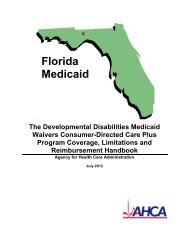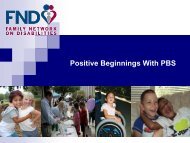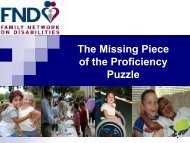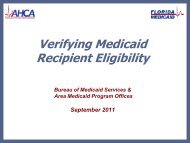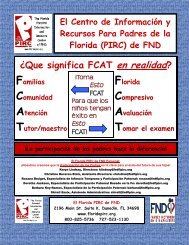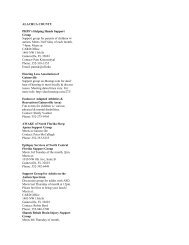Medical Home Models - The Family Network on Disabilities of Florida
Medical Home Models - The Family Network on Disabilities of Florida
Medical Home Models - The Family Network on Disabilities of Florida
- No tags were found...
You also want an ePaper? Increase the reach of your titles
YUMPU automatically turns print PDFs into web optimized ePapers that Google loves.
<str<strong>on</strong>g>Medical</str<strong>on</strong>g> <str<strong>on</strong>g>Home</str<strong>on</strong>g> <str<strong>on</strong>g>Models</str<strong>on</strong>g>:C<strong>on</strong>cepts & UsePresented to the <str<strong>on</strong>g>Medical</str<strong>on</strong>g> <str<strong>on</strong>g>Home</str<strong>on</strong>g> Task ForceSeptember 30, 2009Andrew R. BehrmanPresident and CEO<strong>Florida</strong> Associati<strong>on</strong> <strong>of</strong> Community Health Centers
Understanding <str<strong>on</strong>g>Medical</str<strong>on</strong>g> <str<strong>on</strong>g>Home</str<strong>on</strong>g>:What it is/Is Not• <str<strong>on</strong>g>Medical</str<strong>on</strong>g> <str<strong>on</strong>g>Home</str<strong>on</strong>g> Model is NOT an insuranceproduct.• It is a tool <strong>on</strong> the provider side <strong>of</strong> health careused to improve patient care through a patientcentered, family centered, coordinated approach.• Can be used to establish payment criteria.
• <str<strong>on</strong>g>The</str<strong>on</strong>g> evidence is str<strong>on</strong>g regarding the importance <strong>of</strong> a<str<strong>on</strong>g>Medical</str<strong>on</strong>g> <str<strong>on</strong>g>Home</str<strong>on</strong>g> approach to the delivery <strong>of</strong> health careservices to patients. <str<strong>on</strong>g>The</str<strong>on</strong>g> provider and the patient arec<strong>on</strong>sidered integral and integrated parts <strong>of</strong> the system.Primary care is the anchor to the system, with a str<strong>on</strong>gcoordinated care functi<strong>on</strong>.• Some literature says it exists merely in the form <strong>of</strong>relati<strong>on</strong>ships between provider and patient at its corefuncti<strong>on</strong>. However, the definiti<strong>on</strong>s go as far asspecifying stringent criteria in a case management,patient centered approach using nati<strong>on</strong>al standards.
• Key elements <strong>of</strong> medical home seem to run through all models:• Accessibility for first c<strong>on</strong>tact primary care• L<strong>on</strong>g term pers<strong>on</strong>-focused care• Comprehensive Care such that all health needs within the realm<strong>of</strong> primary care is provided• Coordinated d care is mandated d for patients who need servicesoutside the realm <strong>of</strong> the primary care physician and/or theteam• Some incentives for providers for coordinating care• Evidence shows that the str<strong>on</strong>ger the primary care orientati<strong>on</strong> isin the system, the lower the all-cause mortality is in the l<strong>on</strong>g run.Furthermore, there is compelling evidence to show that investingiin more primary care will lower overall costs for health services
Rati<strong>on</strong>ale• Southeastern C<strong>on</strong>sultants Report <strong>on</strong> <strong>Florida</strong>Medicaid Analysis Shows:• Approx. $900M in total medial and drug costsannually was attributed to adult patients withuncoordinated care patterns• Two indicators as examples:• Average annual drug costs <strong>of</strong> $9,176 vs.$1,640• Average medical costs <strong>of</strong> $13,320 vs $3,479
SEC Recommendati<strong>on</strong>s• Target & expand interventi<strong>on</strong> programs toimprove coordinated care• Physician & pharmacy medical home programsw/targeted enhanced care management• Disease & care management interventi<strong>on</strong>s• Patient educati<strong>on</strong>• ER diversi<strong>on</strong> to redirect patients to primarycare• Providers MUST BE ACTIVE PARTICIPANTSw/patients to achieve coordinated care
Variati<strong>on</strong>s <strong>on</strong> a <str<strong>on</strong>g>The</str<strong>on</strong>g>me• <str<strong>on</strong>g>Medical</str<strong>on</strong>g> <str<strong>on</strong>g>Home</str<strong>on</strong>g> models have a variety <strong>of</strong>implementati<strong>on</strong> strategies, yet for reimbursementno standard d payment strategy t has beenrecognized. Payers experiment with differentmechanisms, but many are beginning gto use theguidelines established by NCQA
NCQA Guidelines• Improved access & communicati<strong>on</strong>• Use <strong>of</strong> data systems to enhance safety andreliability• Care management• Patient self management support• Electr<strong>on</strong>ic prescribing• Referral tracking• Test tracking• Performance reporting/improvement• Advanced electr<strong>on</strong>ic communicati<strong>on</strong>s
<str<strong>on</strong>g>Models</str<strong>on</strong>g> & Standards• PCMH Principles (AAFP, AAP, ACCP, AOA)• Each patient has a pers<strong>on</strong>al physician(development <strong>of</strong> a primary care network isparamount to success)• Physician directed medical practice• Whole oepe pers<strong>on</strong> orientati<strong>on</strong>tato• Care is coordinated/integrated across allelements <strong>of</strong> the health care system
• Quality and safety are hallmarks <strong>of</strong> the medicalhome:• Evidenced-based medicine/clinical decisi<strong>on</strong>-support support toolsguide decisi<strong>on</strong> making• Physicians accept accountability for CQI• Patients participate in decisi<strong>on</strong> making• IT is used extensively• Practices advocate for their patients• Enhanced access to care is available• Payment recognizes the value <strong>of</strong> a PCMH systemand should include incentives
FQHCs• FQHCs have operated within a variati<strong>on</strong> <strong>of</strong>the PCMH model for over 30 years in<strong>Florida</strong>• A str<strong>on</strong>g primary care network is in place via FQHCs,serving close to 1M people this year. Coordinated care isa federal mandate for CHCs.• Working with hospitals and insurance companies toincrease ER diversi<strong>on</strong>s to ensure patients get primarycare• Disease management is a critical aspect <strong>of</strong> CHCintegrati<strong>on</strong> <strong>of</strong> care within the medical home
Select <str<strong>on</strong>g>Medical</str<strong>on</strong>g> <str<strong>on</strong>g>Home</str<strong>on</strong>g> <str<strong>on</strong>g>Models</str<strong>on</strong>g>
So<strong>on</strong>erCare Program• Oklahoma Health Care Authority• 1993 1115 Waiver to reform Medicaid Program to implement astatewide managed care model to c<strong>on</strong>trol costs and improvecare• Modified over next 15 years - implemented a fully capitatedprogram in urban areas and a partially capitated PCCMprogram in rural areas; expanded throughout state in 2004.• As <strong>of</strong> July, 2009 there are just over 675,000 patients (69%children, 31% adults).• THE PCCM approach is the basis for the medical hometransiti<strong>on</strong> which relies <strong>on</strong> FFS reimbursement for <strong>of</strong>fice-basedservices, supplemented by care coordinati<strong>on</strong> payments thatvary with services <strong>of</strong>fered, patient characteristics, andperformance measures.
• Acti<strong>on</strong>sSo<strong>on</strong>erCare Program• Terminated c<strong>on</strong>tracts will all MCOs and brought work in-houseto reduce costs (took out pr<strong>of</strong>it margins, lowered admin costs).• Innovative partial capitati<strong>on</strong> to encourage participati<strong>on</strong> fromphysicians who did not want to see Medicaid patients• Physicians paid about 10% if enrollees total predicted costs upfr<strong>on</strong>t and thenthey were resp<strong>on</strong>sible for providing a specific package <strong>of</strong> <strong>of</strong>fice based PCservices. Other costs paid <strong>on</strong> FFS basis. This would be similar in some waysto our state’s PMPM case management fee for limited coordinati<strong>on</strong>• Established primary care networks and used primary careproviders as coordinators <strong>of</strong> care• 2004 – OHCA established a Nurse Care Management program.Nurses (in-house) are performing many <strong>of</strong> the caremanagement and coordinati<strong>on</strong> functi<strong>on</strong>s the MCOs did, buthave extended this into rural areas as well as urban
So<strong>on</strong>erCare Program• Health Management Program established for highcost, high need patients• Development/implementati<strong>on</strong> <strong>of</strong> <str<strong>on</strong>g>Medical</str<strong>on</strong>g> <str<strong>on</strong>g>Home</str<strong>on</strong>g>Model moving away from partial capitati<strong>on</strong>towards FFS• Expanded Coverage (“Insure Oklahoma”) byhelping small employers coverage
So<strong>on</strong>erCare Key Elements• Stand-al<strong>on</strong>e al<strong>on</strong>e Medicaid agency• OHCA extensive work with MCOs providers, and advocates• Established str<strong>on</strong>g performance measurement capabilitiesto provide reliable data to support key decisi<strong>on</strong>s• Focus <strong>on</strong> providers as clients to improve participati<strong>on</strong>• Medicaid reimbursement is 100% <strong>of</strong> Medicare rates in 2005• C<strong>on</strong>certed outreach, simplified applicati<strong>on</strong>s to increaseenrollment in Medicaid• OHCA has taken advantage <strong>of</strong> the medical home model toenhance the reimbursement system and build in morefinancial incentives for providers to improve theirperformance (Immunizati<strong>on</strong>s, EPSDT, ED Utilizati<strong>on</strong>,Cervical Cancer Screenings)• Effective and C<strong>on</strong>tinuous communicati<strong>on</strong> with stakeholders
Community Care <strong>of</strong> North Carolina• Created to enhance the PCCM program through community basedcoordinated delivery systems• Five key ypprinciples:p• Public-private partnership uniting and strengthening local providers• Physician leadership and local c<strong>on</strong>trol• Focus <strong>on</strong> quality <strong>of</strong> care and populati<strong>on</strong> health management• Shared state/local resp<strong>on</strong>sibility• Shared incentives• Established 14 community care networks• Local networks/PR Providers received supplemental funding forcare management and CQI activities• Each network – vertically integrated (PC, specialty, hospitals,CHDs, other key stakeholders)• Key participati<strong>on</strong> elements: primary/preventive care services, 24hour coverage, coordinating specialty care, participati<strong>on</strong> in caremanagement and CQI activities
Community Care <strong>of</strong> North Carolina• Uses $3 PMPM to cover costs <strong>of</strong> network management activities• <str<strong>on</strong>g>Network</str<strong>on</strong>g>’s management fees are competitive with those chargedby disease management vendors• Physicians are paid FFS at 95% <strong>of</strong> Medicare rates, plus a $2.50PMPM for medical home/populati<strong>on</strong> management activities• Web-based based case management informati<strong>on</strong> system to coordinatecare <strong>of</strong> enrollees. Can be used to ID high risk patients for chr<strong>on</strong>icdisease management• C<strong>on</strong>tracts with AHEC for chart reviews• All CCNC networks work together with state to track and reportperformance measures.• Outcomes have been excepti<strong>on</strong>al• CCNC clinical i l directors developed d a voluntary drug list. used toencourage the use <strong>of</strong> less expensive meds
Community Care <strong>of</strong> North Carolina• <str<strong>on</strong>g>Medical</str<strong>on</strong>g> <str<strong>on</strong>g>Home</str<strong>on</strong>g> Operati<strong>on</strong>• Patient selects or assigned a pers<strong>on</strong>al primary careprovider who serves as medical home• Physician provides acute and preventive services andfacilitates patient access to overall health care system• CCNC has a patient t educati<strong>on</strong> system to engage patienttin healthy lifestyles, preventive services, etc.• HealthNet Collaborative <str<strong>on</strong>g>Network</str<strong>on</strong>g>s• CCNC works with safety-net providers and indigent careprograms to create integrated networks <strong>of</strong> care foruninsured.• From Comm<strong>on</strong>wealth Fund Case Study <strong>on</strong> CCNC
<strong>Florida</strong>’s Challenge• Clearly the medical home tool can have a positive impact<strong>on</strong> health care costs and delivery• <strong>Florida</strong> must decide if it wants to use a medical home modelfor the basis <strong>of</strong> a new delivery system that will improvecare, reduce costs in our state• <strong>Florida</strong> needs to agree <strong>on</strong> what would be the criteria forqualifying for “medical home status”• Look at the elements <strong>of</strong> existing plans and take what can fitfor us.• Must insure a solid primary care network is in place• Must establish fiscal goals as well as quality goals• Do we have the primary care workforce for this?
C<strong>on</strong>cerns• Both models that are highlighted here have populati<strong>on</strong>sthat are significantly lower than <strong>Florida</strong>’s Medicaidpopulati<strong>on</strong>• Costs for increasing reimbursement to the 95-100%range would have an impact for <strong>Florida</strong>• <str<strong>on</strong>g>The</str<strong>on</strong>g> number <strong>of</strong> primary care providers coming out <strong>of</strong>residencies and med school is shrinking for <strong>Florida</strong>• Unlike Oklahoma, <strong>Florida</strong> has a multitude <strong>of</strong> MCOs todeal with, although the agency could address this• <strong>Florida</strong> pays more PMPM than and provides <strong>on</strong>ly 57%Medicare and no incentives than OK who pays about $44PMPM AND pays Medicare plus incentives to providers• <strong>Florida</strong>’s system is not aligned for efficient patient careand cost c<strong>on</strong>tainment
What <strong>Florida</strong> Has• <str<strong>on</strong>g>The</str<strong>on</strong>g> network c<strong>on</strong>cept is loosely the same as the initialc<strong>on</strong>cept <strong>of</strong> the Rural Health <str<strong>on</strong>g>Network</str<strong>on</strong>g>s which in someforms still exist• PSN and vertically integrated can be networks can bedeveloped• FQHCs already have a str<strong>on</strong>g primary care networkstatewide that utilizes the medical home c<strong>on</strong>cept• Private physicians can form str<strong>on</strong>g networks locally• <str<strong>on</strong>g>The</str<strong>on</strong>g>re is not a great deal <strong>of</strong> change needed to adopt thispowerful tool to improve health care in <strong>Florida</strong> otherthan <strong>on</strong> the payor side and the reimbursement strategy
C<strong>on</strong>clusi<strong>on</strong>s• Oklahoma has found a formula to pay higherreimbursements, incentivize PCP to coordinate care, andreduce cost to the state significantly – <strong>Florida</strong> can dothis• North Carolina has taken the community based networkc<strong>on</strong>cept to the state level, with ALL 14 cooperating <strong>on</strong>standard medical home c<strong>on</strong>cepts, reporting, datacollecti<strong>on</strong>, and delivery system utilizati<strong>on</strong> – <strong>Florida</strong> hasnumerous pieces <strong>of</strong> these which can be integrated tomeet the needs
<strong>Florida</strong> needs to shift it’s focus inhealth care from the payor to thehealth system and it’s providersas clients.




